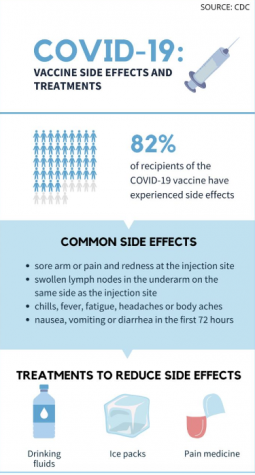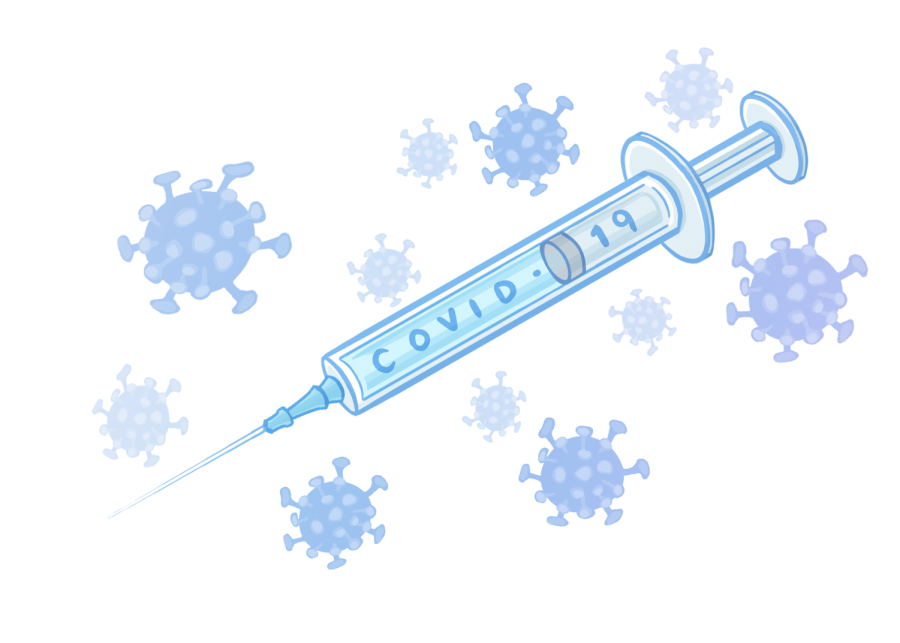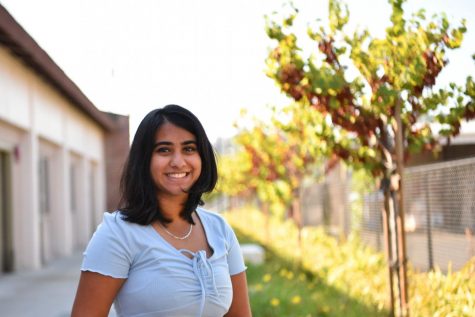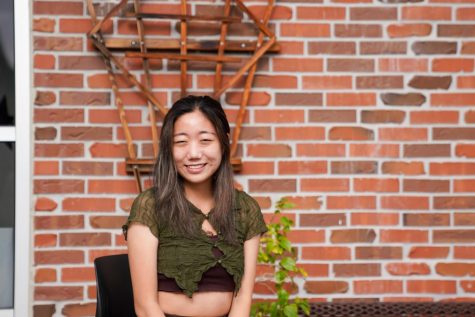Behind both doses
Examining the experiences of getting the COVID-19 vaccine
An illustration of the COVID-19 vaccine Graphic by Sophia Ma
May 21, 2021
On April 15, 2021, California began allowing residents 16 and older to receive the COVID-19 vaccine. Currently, approximately 40% of California residents or 132 million people have received at least the first dose, according to the LA Times.
Senior Austin Ota became eligible for the Pfizer vaccine on Feb. 28, two months before others his age, because he is a theater camp instructor who regularly interacts with young students. On March 1, he went to Levi’s stadium and after filling out the required paperwork and waiting for approximately 15 minutes, he received his first dose.
After receiving the shot, everyone was required to remain on site for an additional 15 minutes to ensure that he had no intense side effects or an allergic reaction. When Ota was cleared, he went home and recounts that he felt “nothing unusual,” only drowsiness — that he attributes to “being a high school student” — and minimal arm pain.
According to a poll by Monmouth University, one in every four Americans refuse to get vaccinated, with one of the primary factors influencing their decision being the fear of side effects. Side effects and their severity depends on the person — for some, they can be intense, and some people may have none.
The CDC reports that the most common side effects are tiredness, headaches, muscle pain, chills, fever, nausea and swelling around the injection site. These side effects may hinder one’s ability to perform everyday activities, but generally subside within 24 hours. Biology teacher Kyle Jones explains that these reactions are a normal part of being vaccinated.
“The symptoms are a result of your immune system responding to the virus, not the virus itself,” Jones said. “You’re getting a response of white blood cells being produced that require energy, so you feel tired and fatigued because your immune system is taking up a lot of energy to fight this off, so all of those symptoms that you experience from the vaccine is actually telling you that your immune system that the vaccine is doing its job [and] is working to respond.”
Senior Rohith Vishwajith also received the Pfizer vaccine as a prerequisite for his eye surgery – he had Keratoconus, a deformed retina, so he needed to undergo a medical procedure to fix it. Similar to Ota, he also felt no serious side effects after the first dose. 
“Generally, it’s going to be the first dose [that] is fine,” Vishwajith said. “The second dose is what hits you harder. [Regarding the] second dose, I was a little more concerned because I had heard about the side effects.”
Vishwajith’s fears were soon put to rest — he reports that after his second dose, the only side effect he felt was arm soreness which he quickly recovered from. Contrasting his experience, Vishwajith notes that both his dad and his friend experienced more serious side effects — his friend ran a fever after his second dose.
According to the CDC, the second dose of the Pfizer and Monderna vaccine is known to induce more intense side effects than the first because the immune response will be stronger since the second dose stimulates the immune system more than the first. But despite the increase in severity, the side effects should still subside within a few days.
Pfizer and Monderna are mRNA vaccines, unlike Johnson and Johnson which is a viral vector vaccine, biology teacher Lora Lerner explains. This means Pfizer and Moderna function similarly — they both require two doses and must be stored at extremely low temperatures. The first dose triggers a primary immune response that will then cause other immune cells to multiply and produce antibodies.
“If you should be exposed to that particular protein or antigen again, [you] would then be able to activate this immune response much more quickly,” Lerner said. “A secondary immune response would generate these immune cells and generate many more of these antibodies, but in a much shorter period of time, and [in] a much stronger response.”
Ota believes that students who are reluctant to get the vaccine should “trust the science” and “trust that the work has been done.” Similarly, AP Biology teacher Pamela Chow urges students to get their vaccines once eligible in order to reach herd immunity, which refers to a resistance to the spread of a virus in a population, a condition that can only be achieved when a large percentage of the population becomes immune to the virus.
“At the moment, I think one of the important things to remember is that the more the virus is allowed to spread, the more [the] mutations would [occur],” Chow said. “Part of the push to vaccinate right now has to do with trying to get things contained because if people aren’t getting vaccinated, the virus is transmitting [at a] higher quantity, [and] I think it is important to realize that vaccination is not just for the individual but it’s also from a community health perspective.”





























